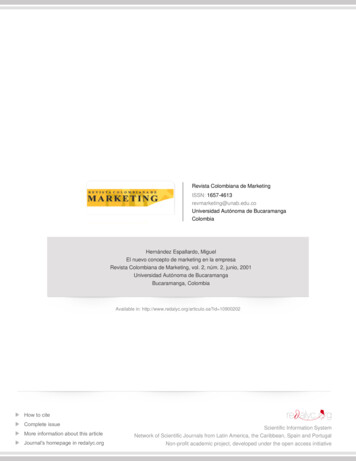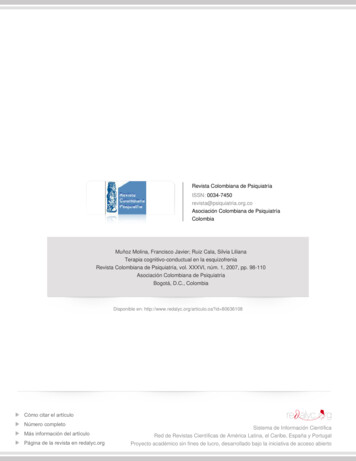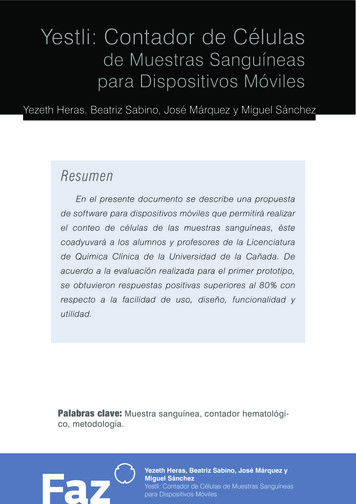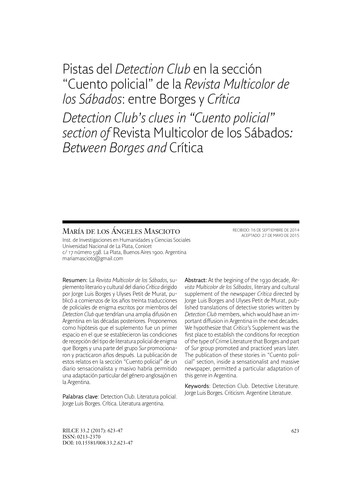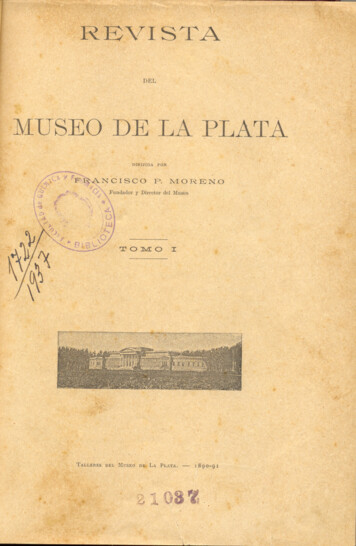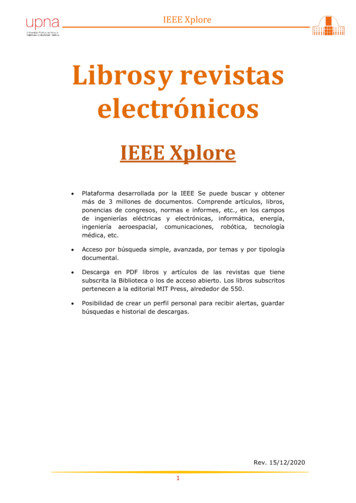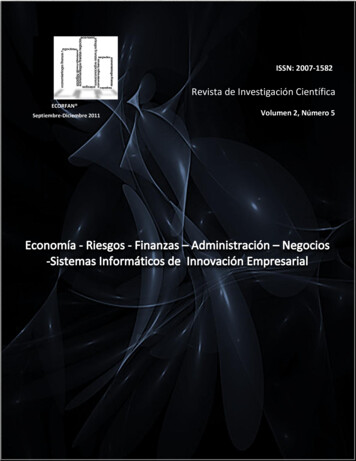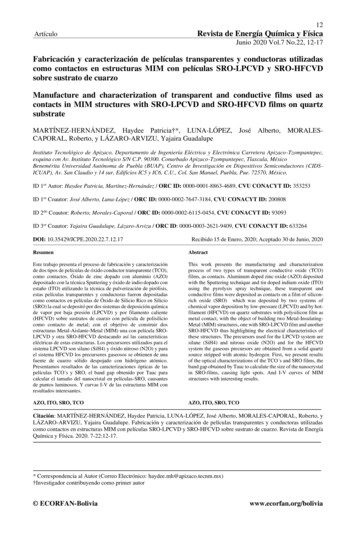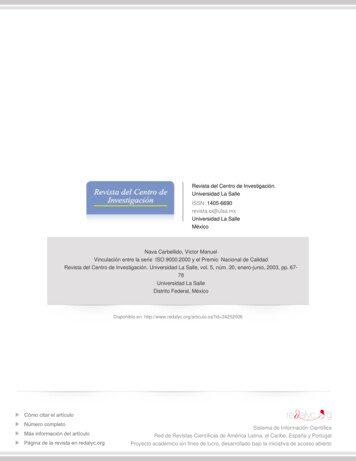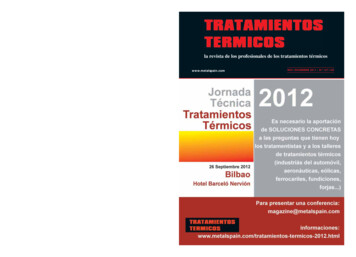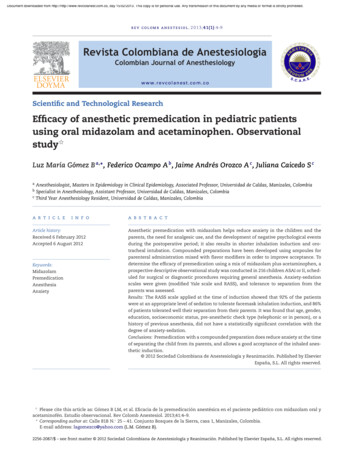
Transcription
Document downloaded from http://http://www.revcolanest.com.co, day 15/02/2013. This copy is for personal use. Any transmission of this document by any media or format is strictly prohibited.r e v c o l o m b a n e s t e s i o l . 2 0 1 3;4 1(1):4–9Revista Colombiana de AnestesiologíaColombian Journal of Anesthesiologywww.revcolanest.com.coScientific and Technological ResearchEfficacy of anesthetic premedication in pediatric patientsusing oral midazolam and acetaminophen. Observationalstudy夽Luz María Gómez B a, , Federico Ocampo A b , Jaime Andrés Orozco A c , Juliana Caicedo S cabcAnesthesiologist, Masters in Epidemiology in Clinical Epidemiology, Associated Professor, Universidad de Caldas, Manizales, ColombiaSpecialist in Anesthesiology, Assistant Professor, Universidad de Caldas, Manizales, ColombiaThird Year Anesthesiology Resident, Universidad de Caldas, Manizales, Colombiaa r t i c l ei n f oa b s t r a c tArticle history:Anesthetic premedication with midazolam helps reduce anxiety in the children and theReceived 6 February 2012parents, the need for analgesic use, and the development of negative psychological eventsAccepted 6 August 2012during the postoperative period; it also results in shorter inhalation induction and orotracheal intubation. Compounded preparations have been developed using ampoules forparenteral administration mixed with flavor modifiers in order to improve acceptance. ToKeywords:determine the efficacy of premedication using a mix of midazolam plus acetaminophen, aMidazolamprospective descriptive observational study was conducted in 216 children ASAI or II, sched-Premedicationuled for surgical or diagnostic procedures requiring general anesthesia. Anxiety-sedationAnesthesiascales were given (modified Yale scale and RASS), and tolerance to separation from theAnxietyparents was assessed.Results: The RASS scale applied at the time of induction showed that 92% of the patientswere at an appropriate level of sedation to tolerate facemask inhalation induction, and 86%of patients tolerated well their separation from their parents. It was found that age, gender,education, socioeconomic status, pre-anesthetic check type (telephonic or in person), or ahistory of previous anesthesia, did not have a statistically significant correlation with thedegree of anxiety-sedation.Conclusions: Premedication with a compounded preparation does reduce anxiety at the timeof separating the child from its parents, and allows a good acceptance of the inhaled anesthetic induction. 2012 Sociedad Colombiana de Anestesiología y Reanimación. Published by ElsevierEspaña, S.L. All rights reserved.夽Please cite this article as: Gómez B LM, et al. Eficacia de la premedicación anestésica en el paciente pediátrico con midazolam oral yacetaminofén. Estudio observacional. Rev Colomb Anestesiol. 2013;41:4–9. Corresponding author at: Calle 81B N. 25 – 41. Conjunto Bosques de la Sierra, casa 1, Manizales, Colombia.E-mail address: lagomezco@yahoo.com (L.M. Gómez B).2256-2087/ – see front matter 2012 Sociedad Colombiana de Anestesiología y Reanimación. Published by Elsevier España, S.L. All rights reserved.
Document downloaded from http://http://www.revcolanest.com.co, day 15/02/2013. This copy is for personal use. Any transmission of this document by any media or format is strictly prohibited.5r e v c o l o m b a n e s t e s i o l . 2 0 1 3;4 1(1):4–9Eficacia de la premedicación anestésica en el paciente pediátrico conmidazolam oral y acetaminofén. Estudio observacionalr e s u m e nPalabras clave:La premedicación anestésica con midazolam, permite disminuir la ansiedad de los niñosMidazolamy los padres así como los requerimientos analgésicos, la aparición de eventos psicológi-Premedicacióncos negativos en el postoperatorio, y acorta los tiempos de inducción inhalatoria de laAnestesiaintubación orotraqueal. Se han desarrollado preparaciones magistrales utilizando ampollasAnsiedadde administración parenteral mezcladas con sustancias que modifican su sabor para mejorar la aceptación. Para determinar la eficacia de la premedicación con midazolam mezcladocon acetaminofén se realizó un estudio observacional descriptivo prospectivo en 216 niñosASAI o II sometidos a procedimientos quirúrgicos o diagnósticos que requerían anestesiageneral; se aplicaron escalas de ansiedad-sedación (Yale modificada y RASS) y se valoró latolerancia a la separación de los padres.Resultados: La escala de RASS aplicada al momento de la inducción evidenció que el 92%de los pacientes se encontraban en un grado adecuado de sedación para tolerar la máscarafacial y la inducción inhalatoria, y además el 86% de los pacientes toleró de manera adecuadala separación de sus padres. El 61,6% de los pacientes se encontraban con un grado adecuadode sedación ansiólisis con la escala de Yale, previo al momento de la separación de lospadres. Edad, género, escolaridad, estrato socioeconómico, tipo de valoración preanestésicao antecedente de anestesia no se correlacionaron con el grado de ansiedad-sedación.Conclusiones: La premedicación con la mezcla magistral utilizada disminuye la ansiedad enel momento en que el niño se separa de sus padres y permite una buena aceptación de lainducción anestésica inhalada. 2012 Sociedad Colombiana de Anestesiología y Reanimación. Publicado por ElsevierEspaña, S.L. Todos los derechos reservados.IntroductionAnesthetic premedication is a frequent practice in pediatricanesthesia services. It has been shown to reduce anxiety inthe children and their parents at the time they are taken tothe operating room, the analgesic requirements, and the timerequired for inhaled induction and orotracheal intubation. Ithas also been found to prevent the development of negativepsychological events during the post-operative period.1–3The use of pharmacological premedication has shown tobe more cost-effective for controlling anxiety when compared with the use of non-pharmacological means such asthe presence of the parents during induction, or behavioralpreparation programs before surgery.3,4Midazolam has been used extensively for pharmacological premedication, with adequate results.5–7 Considering thatthere is no oral midazolam in our setting, compoundinghas been done using ampoules for parenteral administrationmixed with some flavor modifiers in order to improve acceptance by the children and also to avoid the anxiety caused byneedles.6,8,9At the Red Cross Children’s University Hospital in Manizales, a compounded preparation has been used since 2000,consisting of a mix of midazolam ampoules 15 mg/3 ml plusacetaminophen suspension 150 mg/5 ml. At the institution,the mix is known as “midazophen”, and after it is prepared itconsists of midazolam 1 mg/ml and acetaminophen 24 mg/ml.The dose used is half the body weight in cubic centimeters,which is equal to 0.5 mg/kg of oral midazolam and 12 mg/kg ofacetaminophen. The dose is given orally to patients scheduledfor elective surgery. The objective of this descriptive study isto assess the efficacy of this premedication, measuring thedegree of anxiety in the children when they are separatedfrom their parents and, in particular, the degree of sedationobtained at the time of inhaled induction.Materials and methodsAfter approval by the Ethics Review Board of the Children’sHospital, a prospective descriptive observational study wasundertaken with 216 pediatric patients scheduled for surgical or diagnostic procedures requiring anesthesia at the RafaelHenao Toro Children’s Hospital in Manizales (Caldas, Colombia), a Level III healthcare institution.All patients that met the inclusion criteria betweenSeptember 2010 and January 2011 were included.Informed consent was obtained for the observation and thereview of the clinical record from the guardians of the children.The inclusion criteria were patients ASA I or II, under 8 yearsof age, scheduled for elective surgery or diagnostic proceduresrequiring anesthesia, and who were prescribed anxiolyticpremedication with midazolam plus acetaminophen by theanesthesiologist. The presence of a known malignancy or of amental disease was considered as an exclusion criterion.During the preoperative assessment, the anesthesiologist gathered demographic information (age, gender, weight,schooling and socioeconomic status), aside from the usualinformation for the anesthesia record. The information wasrecorded in the instrument designed for the study. Mostpatients coming from areas located far away from the city
Document downloaded from http://http://www.revcolanest.com.co, day 15/02/2013. This copy is for personal use. Any transmission of this document by any media or format is strictly prohibited.6r e v c o l o m b a n e s t e s i o l . 2 0 1 3;4 1(1):4–9Table 1 – Scales use for measuring anxiety and sedation.1. Modified Yale scaleEmotional expressivityHappyNeutral with no visible expressionSad, worriedCryingInteraction with relativesHas fun, sits stillSeeks contact with relativesLooks at relatives quietly, does not seek contactPushes parents away or clings and does not let themgoActivityCurious, plays in the roomDoes not explore, sits close to relativesSquirming, moving on tablePushes with hands and feet and tries to get awayApparent state of arousalAroused, looks around confidentlyQuiet, withdrawnFearful, cries easilyCries and does not want others nearVocabularyAsks questions, babbles, laughsReplies in whispers or just moves the headStill, does not reply to questionsDistressed, grumpyCrying loudly, screamingCrying, loud constant screaming2. Separation from parentsCryingIndifferentQuiet3. Richmond-RASS scale 4 Aggressive, violent 3 Very agitated. Tries to remove the lines 2 Agitated. Frequent movements 1 Anxious. Worried but no violence0 Alert, quiet 1 Sleepy, wakes to the sound of voices. Opens eyes more than 10 s 2 Does NOT open eyes more than 10 s 3 Moderate sedation. Opens eyes, does not fix gaze 4 Deep sedation, does not respond to voice but does respond to physical stimulus 5 Very deep sedation, does not respond to physical stimulusModified Yale scale and Richmond-RASS scale, adapted from: Kain ZN, Mayes LC, Cicchetti DV et al. The Yale Preoperative Anxiety Scale: howdoes it compare with a “gold standard”? Anesth Analg. 1997;85:783–8 and Sessler CN, Gosnell MS, Grap MJ et al. The Richmond AgitationSedation Scale: validity and reliability in adult intensive care unit patients. Am J Respir Crit Care Med. 2002;166:1338–44; Scale of separationfrom the parents: developed originally by the authors.of Manizales received a phone call a few days before theprocedure in order to gather information about their history,and to determine the use of midazolam plus acetaminophen.On the day of the surgery, based on the information alreadygathered, the patients arrived with their guardians at theAmbulatory Surgery services where they were given the indicated dose of the compounded mix. Before they were takento the operating room, the patients were again assessed bythe attending anesthetist, and given the modified Yale scale.The degree of anxiety at the time of separation from the parents was recorded also (see Table 1 for the anxiety assessmentscales). Patients were taken on a stretcher to the operatingroom, and after setting up basic monitoring, inhaled induction was initiated using sevoflurane. At that point (1 min),the Richmond-RASS sedation-agitation scale was applied (seeTable 1). The anesthetic and surgical procedures were carriedout in accordance with the institutional standards, and noother measurements were made. Before starting data collection, a pilot test was conducted with 15 cases, and this allowedrevision of some technical issues of the tool.Once the information was collected, it was analyzed usingthe statistical SPSS package. The three outcome variablesanalyzed were the three sedation and anxiety measurementscores used at three different points of time. The adequateor optimal levels for the three scales were as follows: valuesranging between 23.4 and 30 on the Yale scale, a quiet or indifferent child at the time of separation for the degree of anxiety,and a score of 0 or 1 on the Richmond-RASS scale at the timeof induction.A characterization of the population, social and demographic data was performed for the statistical analysis, usingdescriptive statistical tools such as the mean and the standarddeviation.The social, demographic, medical and anesthetic variablesincluded in the form were correlated with the outcome variables of sedation efficacy using the Chi-Square test.ResultsThe sample collected included 216 patients ranging between6 months and 8 years of age. Of these, 31.5% (68) were femalesand 68.5% (148) were males. A description of the demographicvariables of the study population is shown in Table 2.
Document downloaded from http://http://www.revcolanest.com.co, day 15/02/2013. This copy is for personal use. Any transmission of this document by any media or format is strictly prohibited.7r e v c o l o m b a n e s t e s i o l . 2 0 1 3;4 1(1):4–9Table 2 – Demographic and population variables.VariablesAge (years)Weight (kg)Schooling (years)Table 3 – Results for the Richmond-RASS scale.Mean (SD)3.17 (1.94)15.4 (4.2)0.97 (1.04)Value ofthe scale43n (%)2GenderMaleFemale148 (68.5)68 (31.5)Prior anesthesiaYesNo75 (34.7)141 (65.2)Preoperative assessmentIn advanceBy telephone203 (93.9)13 (6.1)The application of the Yale scale showed adequate sedation and anxiolysis in 61.6% of the patients. It is worth notingthat at the time of the evaluation, the time elapsed betweenthe moment the drug was given until the scale was appliedwas within an ideal range (15–90 min) only in 25% of the children. Moreover, of the 55 patients in whom the administrationinterval was appropriate, 60% were found to be anxious, and40% were not anxious. These variations preclude any validconclusions for this phase.When the sedation-anxiolysis scale was applied at the timethe children were separated from their parents, it showed that86% (186) of the children were indifferent or quiet. At thisstage, there was no evaluation of the time elapsed from themoment the midazolam–acetaminophen mix was given. However, this must have happened approximately 10 min after theprevious phase.The Richmond-RASS scale applied at the time of inductionshowed that 70% (152) of the patients had adequate sedation(score between 1 and 0), which resulted in easy and quietacceptance of the facemask. When the 39 children whosescore on this scale was 1 are added to this group, the percentage rises to 92%. Table 3 shows the data obtained for eachscore on this scale.In terms of the time elapsed between the administrationof the drug and the induction of general anesthesia, optimumtime was achieved in 89% (192) of the patients (ranging from15 to 90 min). Of the patients in whom optimum time wasnot achieved, 12 patients had less than 13 min between themoment they were given the compounded mix and the timeof anesthesia induction.There was no statistically significant correlation amongvariables such as age, gender, schooling, socioeconomic status, type of anesthetic check (by telephone or in person), or ahistory of prior anesthesia, and the presence of anxiety at thetime of applying the Yale scale, or with the degree of sedationat the time of anesthesia induction.DiscussionSedation obtained by means of pre-medication enhancespediatric patient cooperation at the times of highest anxiety during the perioperative period – separation from the10 1 2 3 4 5VariableAggressive. Violent.Very agitated. Tries to pullthe catheterAgitated. Frequentmovements.Anxious. Worried, but notviolent.Alert, quiet.Sleepy, awakes to the soundof a voice. Opens eyesduring more than 10 s.Does NOT open the eyes formore than 10 s.Moderate sedation. Openseyes, does not fix gaze.Deep sedation, does notrespond to voice, but doesrespond to physicalstimulus.Very deep sedation, noresponse to physicalstimulus.Patients with thisvalue n 216n (%)5 (2.3)7 (3.2)11 (5.1)39 (18.1)147 (68.1)5 (2.3)1 (0.5)01 (0.5)0parents and anesthetic induction – and creates a tear-freeenvironment and a more reassuring atmosphere for the otherpatients, the parents and the caregivers. An additional benefitis a lower incidence of post-operative emotional disturbancesthat might create emotional morbidity in the long run.10,14Several strategies have been used to obtain adequatesedation. Among them, one of the most effective is the pharmacological strategy, midazolam being one of the drugs ofchoice because of ease of administration, safety, good bioavailability when given orally, and because it does not delayemergence from anesthesia or the time to discharge from therecovery unit.11,2,12Reducing perioperative anxiety must be one of the mostimportant objectives in pediatric anesthesia, because anxietyhas been associated with postoperative adverse events suchas increased pain and negative behavioral changes, includingpsychomotor agitation at emergence, crying, disorientation,post-operative delirium, sleep disorders and avoidance behaviors in medical and hospital environments, which may lasteven up to 2 weeks after the procedure.13,14The modified Yale scale was applied prior to separationfrom the parents, in the waiting room, in order to assessthe presence or absence of anxiety at that point in time,13and anxiety was found in 61.6% of patients. This might beexplained because the time elapsed between the administration of oral midazolam and that point in time was notadequate in most cases (14 min in average). The time elapsedbetween the administration of oral midazolam and the onsetof action has been described as 5–10 min, with a peak clinicaleffect at 20–30 min, and waning between 45 and 90 min. However, of the 55 children in whom the time was adequate, 33(33/55 60%) were anxious and 22 (22/55 40%) were not. Consequently, there probably are other conditioning factors thatwere not considered, such as those mentioned in some studies that show that individual behavioral disorders are directly
Document downloaded from http://http://www.revcolanest.com.co, day 15/02/2013. This copy is for personal use. Any transmission of this document by any media or format is strictly prohibited.8r e v c o l o m b a n e s t e s i o l . 2 0 1 3;4 1(1):4–9related with failure of adequate sedation16 ; in our study, theevaluation of existing personality traits was not included asan objective. On the other hand, it is important to considerthat the Yale scale was designed to determine whether anxiety is present or not, but not to determine its degree.13,15Consequently, several children could have experienced imperceptible degrees of anxiolysis. Studies with the participationof psychology professionals might provide more specific information in this regard.As stated previously, there are several critical momentswhen sedation is more important. The first one is when thechild is separated from its parents before entering the operating room, and the next one is during inhaled anestheticinduction.15 In our study, at the time of separation from theirparents, 86% of the children appeared quiet. Other studies, likethe one by Rosenbaum et al. have shown that seeing a quietchild improves parental satisfaction.10Another moment that might be traumatic and stressful for the child and might create psychological sequelaeis anesthetic induction with the use of a facemask. Severalstrategies have been used to overcome this problem, withvarying degrees of success.15–18 Our study found that 70.4% ofthe patients showed good acceptance of the anesthetic induction, with good tolerance of the facemask; these results aresimilar to those reported by other authors.11 However, whenpatients with a RASS score of 1 (see Table 3), which is acceptable for anesthetic induction and tolerability of the facemask,are added in this study, then 92% of patients had good acceptance.There are several sources of error in our study, including the range of time periods between the administration ofthe drug and the various assessments, a variable that wasimpossible to standardize given the particular administrativeand healthcare processes of the institution. A second potential source of error is the fact that chemical testing has notfound a homogenous concentration of midazolam in the compound prepared at our Hospital; however, the staff is alwayscareful to shake the vial containing the drugs before administering the compound. The third potential source of erroris that, although the vast majority of children accepted themix easily because of its nice flavor, significant amounts ofthe dose may have been lost during the process of administration, thus affecting the results; however, since there isno quantitative measurement of plasma levels of the medication, there is no way to establish this fact objectively. Thefourth source of error is the fact that personality traits were notcorrelated with the results of the premedication, because theassessment scales have not been validated fully. There was nocomparison group because the efficacy of premedication hasbeen clearly demonstrated in the world literature, and we didnot think it was ethical to deprive the patients of its benefits,because our main objective was to provide objective proof ofthe usefulness of an experience based practice. However, if acontrol group is required, the administration of another drugconsidered useful as anesthetic premedication, or the use ofnon-pharmacological measures, may also be considered.It has been described that acetaminophen may shortengastric emptying, which could increase the bioavailabilityof midazolam and shorten the time required to achieve itsclinical effect. This may interfere to a certain degree with ourresults when compared to those of other authors.19 The significance of this phenomenon must be assessed in future studiesabout this topic.Intravenous midazolam combined with other drugs suchas fentanyl and propofol has been used for deep sedation inpatients taken to magnetic resonance imaging. Oral midazolam together with acetaminophen might probably be agood and safe option in less complex, non-painful diagnostictests.20ConclusionIn the light of the results obtained, premedication withcompounded midazolam plus acetaminophen used at theManizales Children’s Hospital is useful: it reduces anxiety atthe time when the children are separated from their parents,and it leads to good acceptance of inhaled anesthesia induction, improving the whole experience, both for the children aswell as for the parents.FundingCaldas University, Red Cross Children’s Hospital, Manizales,Colombia.Conflict of interestThe authors have no conflicts of interest to declare.AcknowledgmentsThe authors would like to thank Universidad de Caldas,Hospital Infantil de la Cruz Roja de Manizales Staff and Biostatistician Luz Marina Agudelo.references1. Baroncini S, Villani A, Serafini G. Anestesia neonatal ypediátrica. 13th ed. Elsevier; 2006. p. 21–33.2. Bailey Jr PD, Bastien JL. Preinduction techniques for pediatricanesthesia. Curr Opin Anaesthesiol. 2005;18:265–9.3. Rosenbaum A, Kain ZN, Larsson P, Lonnqvist PA, Wolf AR. Theplace of premedication in pediatric practice. PaediatrAnaesth. 2009;19:817–28.4. McCann ME, Kain ZN. The management of preoperativeanxiety in children: an update. Anesth Analg. 2001;93:98–105.5. Singh N, Pandey RK, Saksena AK, Jaiswal JN. A comparativeevaluation of oral midazolam with other sedatives aspremedication in pediatric dentistry. J Clin Pediatr Dent.2002;26:161–4.6. Sheta SA, Alsarheed M. Oral midazolam premedication forchildren undergoing general anaesthesia for dental care. Int JPediatr. 2009:274–380.7. Arevalo J, Duque J. Utilidad del midazolam oral comomedicación preoperatoria en el paciente pediátrico. Trabajode grado. Facultad de Medicina, Universidad de Caldas;1991.
Document downloaded from http://http://www.revcolanest.com.co, day 15/02/2013. This copy is for personal use. Any transmission of this document by any media or format is strictly prohibited.r e v c o l o m b a n e s t e s i o l . 2 0 1 3;4 1(1):4–98. Shrestha S, Shrestha BR. Oral administration of intravenoussolution of midazolam mixed in syrup of paracetamol is aneffective way of premedicating children undergoing surgeryunder general anaesthesia. Kathmandu Univ Med J (KUMJ).2007;5:449–55.9. Yuen VM, Hui TW, Irwin MG, Yuen MK. A comparison ofintranasal dexmedetomidine and oral midazolam forpremedication in pediatric anesthesia: a double-blindedrandomized controlled trial. Anesth Analg. 2008;106:1715–21.10. Rosenbaum A, Kain ZN, Larsson P, Lönnqvist PA, Wolf AR. Theplace of premedication in pediatric practice. PaediatrAnaesth. 2009;19:817–28.11. Isik B, Baygin O, Kapci EG, Bodur H. The effects oftemperament and behaviour problems on sedation failure inanxious children after midazolam premedication. Eur JAnaesthesiol. 2010;27:336–40.12. Horgesheimer JJ, Pribble CG, Lugo RA. The effect ofmidazolam premedication on discharge time in pediatricpatients undergoing general anesthesia for dentalrestorations. Pediatr Dent. 2001;23:491–4.13. Fortier MA, Del Rosario AM, Martin SR, Kain ZN. Perioperativeanxiety in children. Paediatr Anaesth. 2010;20:318–22.914. Davidson A, McKenzie I. Distress at induction: prevention andconsequences. Curr Opin Anaesthesiol. 2011;24:301–6.15. Vagnoli L, Caprilli S, Messeri A. Parental presence, clowns orsedative premedication to treat preoperative anxiety inchildren: what could be the most promising option? PaediatrAnaesth. 2010;20:937–43.16. Bozkurt P. Premedication of the pediatric patient – anesthesiafor the uncooperative child. Curr Opin Anaesthesiol.2007;20:211–5.17. Kazak Z, Sezer GB, Yilmaz AA, Ates Y. Premedication withoral midazolam with or without parental presence. Eur JAnaesthesiol. 2010;27:347–52.18. Navas G. ¿Cómo evitar que la inducción anestésica searecordada como un proceso traumático? In: AnestesiologíaPediátrica. Bogotá: Sociedad Colombiana de Anestesia-Scare,Medilegis; 2003. p. 68–79.19. Oscier CD, Milner QJ. Peri-operative use of paracetamol.Anaesthesia. 2009;64:65–72.20. Delgado JA, Abad P, Angel GJ, Llano JF, Gómez FJ, Calvo VD.Uso de sedación profunda asistida por un anestesiólogo enresonancia magnética para población pediátrica. Rev ColombAnestesiol. 2010;38:487–97.
a Anesthesiologist, Masters inEpidemiology Clinical Epidemiology, Associated Professor, Universidad de Caldas, Manizales, Colombia b Specialist in Anesthesiology, Assistant Professor, Universidad de Caldas, Manizales, Colombia c Third Year Anesthesiology Resident, Universidad de Caldas, Manizales, Colombia a r t i c l e i n f o Article history .
